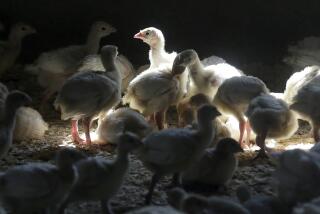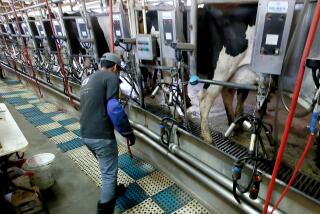CDC Sends Mumps Vaccine
Federal health authorities said Wednesday they were sending 50,000 doses of mumps vaccine to Iowa and other affected areas in an effort to control the largest outbreak in 20 years.
Since the first cases were detected in Iowa in December, mumps has infected 1,165 people in at least eight Midwestern states, said Dr. Julie L. Gerberding, director of the Centers for Disease Control and Prevention.
“We are not going to be surprised if there are more cases in more states,” she said at a news conference in Atlanta.
Officials are still collecting data from the other states, but many of Iowa’s 815 patients were 17 to 24 years old.
The relative youth of those infected could explain why there have been no deaths so far, Gerberding said. Twenty people have been hospitalized for serious conditions from their mumps infection, including meningitis.
Gerberding said a crash program had begun in affected areas to vaccinate vulnerable populations, particularly college-age students and healthcare workers.
Mumps is a virus that can be spread by close contact through mucus or coughs and sneezes.
The disease generally causes fever, headaches and tiredness, with a special tendency to puff up the saliva glands. Most people recover in about 10 days. About 20% of people who catch mumps have mild or no symptoms.
Mumps usually affects about 265 people a year in the U.S.
Since a vaccine for measles, mumps and rubella became available in 1967, nearly everyone has gotten the shot.
Jane Seward, acting deputy director of the CDC’s division of viral diseases, said the latest outbreak might have been sparked by someone coming from overseas.
Health officials said the mumps strain was the same as one circulating in the United Kingdom, which has seen 100,000 cases since 2004.
The disease seems to have landed in a pocket of vulnerable people, Seward said.
A significant number of college-age students in Iowa have not had their second dose of vaccine because they entered school before the requirement for a second dose took effect in the early 1990s.
Iowa does not require students entering college to have a second dose of the vaccine.
The federal government now recommends the vaccine at 12 to 15 months and 4 to 6 years of age.
There is no evidence that immunity conferred by the vaccine diminishes with time, but the vaccine still fails to protect 10% of the people who receive the recommended two doses, Gerberding said.
Crowded conditions in dormitories make colleges a prime breeding ground for the disease, she said.
Iowa has seen the bulk of the cases, but 350 have been reported in Minnesota, Kansas, Illinois, Wisconsin, Nebraska, Missouri and Oklahoma.
Gerberding said her agency was investigating possible cases in seven other states, but she declined to specify which ones.
Health officials in California said there had been five cases so far this year. None of the cases appear to be linked to the Midwest outbreak, said Celia Woodfill, an epidemiologist at the California Department of Health Services.
The state usually sees about 50 cases of mumps a year, usually in isolated clusters of less than five people, Woodfill said.
More to Read
Sign up for Essential California
The most important California stories and recommendations in your inbox every morning.
You may occasionally receive promotional content from the Los Angeles Times.










